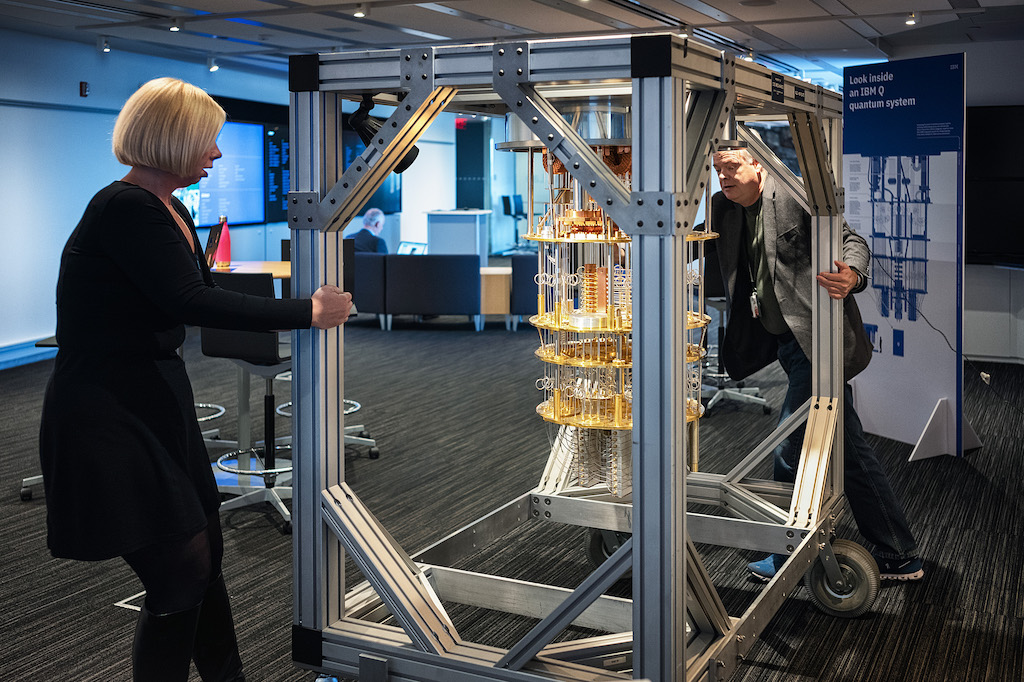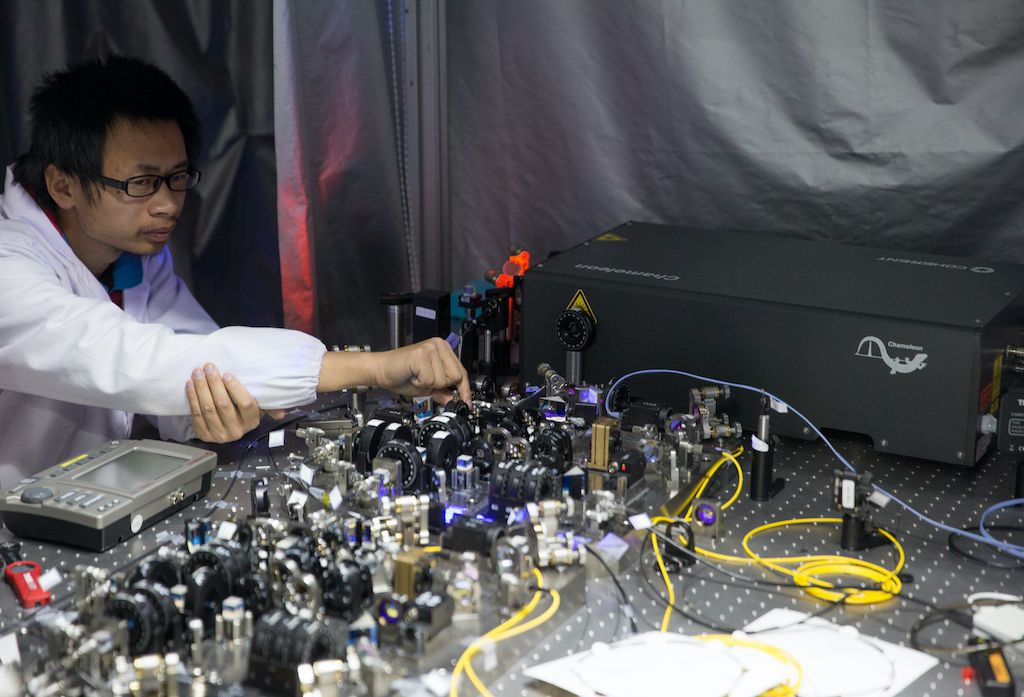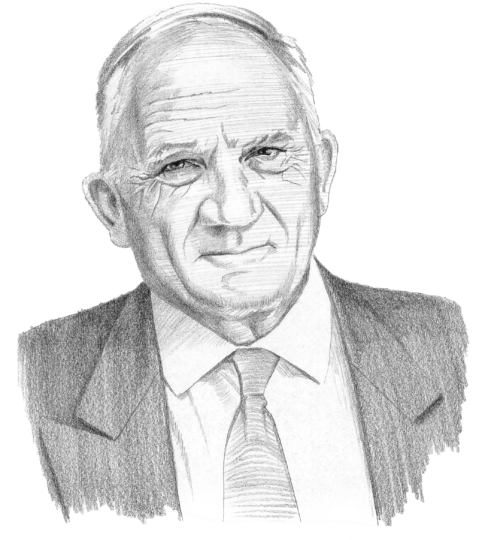Quantum computing may alter our civilization beyond recognition
China, the United States and other technologically advanced countries are in an epic race to develop commercial quantum computers. The state that achieves an early breakthrough in this contest could gain military, economic and geopolitical advantages of historic proportions.

In a nutshell
- Quantum computing carries both risks and opportunities
- The U.S. and China are rivals in this all-out scientific race
- The technology has the potential to profoundly alter civilization
Advancing quantum computing promises to expand human knowledge radically and further reshape the nature of technological innovation. However, these same developments could profoundly affect international security and shift the global political and economic balance of power.
Many nations – in particular, the United States and China – recognize the promises and perils of a quantum revolution and are doubling down on strategies to realize its attendant benefits while mitigating its most significant risks.
In late August 2020, the Trump administration announced a $1 billion program to advance American leadership in quantum computing and artificial intelligence. The program includes more than $300 million from industry and academia for five new research centers within the Department of Energy and another $140 million in funding for the National Science Foundation.
The race
More than just another U.S. government spending program, this and other initiatives directly respond to quantum research and advancement taking place in China. In 2016, China surprised many observers when it launched the first known Quantum Science Experiment Satellite into low-Earth orbit. The satellite (nicknamed Micius after a 5th-century Chinese philosopher and scientist), was used in 2017 to hold a quantum-encrypted video call between Chinese and Australian scientists. A ground-based network in northern China’s Shandong province has also been built, providing proof of concept for a quantum-encrypted internet.
China missed out on the digital revolution and doesn’t want to be caught napping this time as well.
There is every reason to believe that more Chinese advancements are around the corner. The number of scholarly articles citing Chinese technology research is also growing – even when compensating for concerns about citation inflation and other forms of fraud. The country is increasingly seen as a leader and innovator within the research community. In 2014, China was already filing about the same number of quantum-computing patent applications as the U.S. By 2017, there were twice as many Chinese filings as American ones.
Commenting on China’s drive, Robert Young, director of the Lancaster Quantum Technology Centre and an adjunct professor at the Institute of Fundamental and Frontier Science in Chengdu, explains that “China basically missed out on the digital revolution and that really set them and their economy back. It doesn’t want to be caught napping again.”
But what is quantum computing? And why is this such an important field of competition in the broader contest between the U.S. and China for technological leadership?
The basics
Quantum science is scientific research stemming from quantum theory, the governing hypothesis of how nature works at the level of atoms, photons, and other subatomic particles. The word “quantum” refers to the notion that all energy, light and matter is composed of discrete units or quanta. Two critical phenomena within quantum physics differentiate it from classical physics and appear to hold tremendous promise for future innovation. The first phenomenon is particle superposition.
Classic physics states that two things cannot occupy the same space at the same time or be wholly present in more than one place at a time. Quantum physics, however, posits that the world is held together by objects that exist in two distinct states simultaneously: this state is called superposition. For example, a molecule consists of two atoms “glued” together by an electron. According to the classic (Newtonian) physics view, this electron could be associated with either atom; however, quantum theory insists that this single electron must be associated with each atom at the same time for them to be properly joined. This is the only way scientists can explain phenomena like photosynthesis and lasers.

The other critical phenomenon, entanglement, is equally mystifying. It describes the ability of separated quantum objects to share a condition or state. Imagine a situation when two or more quantum objects become linked so that any measurement of one immediately determines the others’ state – regardless of the distance between them. It is as if there were two spinning coins on opposite sides of the universe and whenever one stops spinning, the other also stops and displays the same value (e.g., heads or tails). Albert Einstein famously rejected entanglement as “spooky action at a distance,” but it has since been demonstrated in multiple experiments, including a Chinese test using pairs of photons separated by more than 745 miles.
Having laid this foundation, we can now discuss quantum computing.
Two quantum computer types
Quantum computers use quantum mechanics’ unique properties to enable data processing that is exponentially more powerful – at certain tasks – than any supercomputer ever built. At their most basic level, conventional computers store and use information as individual bits, which encode information as either a “0” or a “1.” Typical computer programs manipulate millions of bits in complicated patterns to accomplish defined tasks.
Leveraging superposition, quantum computers produce bits that can not only be “1 or 0,” but also “1 and 0” at the same time. These small shapeshifters are called “qubits.” The qubits can be entangled and used to express and to test probabilities at scales and speeds currently unachievable with a traditional computer. Moreover, with every qubit added to a microchip, the microchip’s processing and probabilistic power grow exponentially.
Even as researchers advance these and other approaches to quantum computing, significant technical challenges remain.
There are multiple approaches to building quantum computers – each with their strengths and weaknesses. The two methods that appear to hold the most promise are the adiabatic quantum computer (“annealer”) and the Gate Model quantum computer (“standard model”).
An adiabatic quantum computer uses a formula known as the adiabatic theorem1 to perform calculations and is best suited for optimizing problems. The key point about this class of quantum computers is that they are the easiest to build, but they can only perform a specific function. Even so, companies like Google are betting big on this approach and many believe quantum annealers—quantum computers focused on a discrete dataset—will constitute an essential evolutionary step toward a general quantum computer.
A Gate Model quantum computer is far more complex because these machines perform calculations using quantum application “gates” – a primary quantum circuit leveraging multiple entangled qubits. Unlike the task-specific adiabatic approach, Gate Model quantum computers build blocks of these quantum gates to mimic conventional computing. Theoretically, at least, they are closer to a general-purpose computer.
Not there yet
Even as researchers advance these and other approaches to quantum computing, significant technical challenges remain. The most fundamental of these is “noise.” Noise is shorthand for small unwanted variations in data or the physical environment that disrupt or prevent efficient computation. Classical computers are very good at removing noise. Qubits and the complex computing environments that they require, however, remain critically vulnerable to noise.
While it is sometimes possible to run a quantum error correction (QEC) algorithm to emulate a noise-free environment, there is a high operational cost for doing so. These QECs require large numbers of qubits and dramatically reduce the quantum computer’s overall computational power. Thus far, researchers have not produced the necessary number of stable qubits to absorb this cost while sustaining meaningful quantum computational power. These and other challenges mean quantum computers are still a theoretical – not a guaranteed – computing approach.
Potential consequences
If quantum computers are fully realized – and that is still a very large “if” – it is no exaggeration to say they could fundamentally change our understanding of the world. Modern science can only speculate on what transpires at the subatomic level. We see different phenomena and often make informed guesses about their causes; however, rarely are we able to observe the causes or the processes they form.
For example, when testing experimental cancer treatments, researchers can see that a specific chemical compound produces a particular biochemical reaction in the body and that triggering this response appears to slow the replication and spread of cancer cells around the body. But why this is the case is not truly understood because we have no way to observe or to model the subatomic processes behind it all. There is just too much data to collect and to process for traditional computers to keep up.
Google, IBM, Microsoft and other technology companies provide access to their quantum programs.
A real quantum computer, empowered by quantum sensors, however, could leverage the scale and speed of quantum mechanics to meet this challenge – opening up an entirely new realm of scientific knowledge that could be applied in virtually every discipline. Such an expansion of knowledge could secure a nation’s technological dominance for the foreseeable future, while missing out could produce a “knowledge gap” that would be difficult, if not impossible, to overcome.
Scenarios
The most likely near-term scenario is that nations and industry will make meaningful but incremental progress on quantum computing hardware and more significant advances in quantum-optimized software. While quantum computers have come a long way in the last five years, there are still fundamental physics challenges to building these machines that require more study and experimentation. While this innovation’s potential value ensures it will remain a key focus, a general-purpose quantum computer is likely a decade or more away.
Software development is progressing more quickly. Because a quantum computer’s underlying math can be known, software developers are already building advanced quantum-enabled programs that need the requisite hardware to run. Google, IBM, Microsoft and other technology companies provide access to their quantum programs for experimentation. The U.S.’s National Institute of Standards and Technology is pioneering a software development program for securing American networks against quantum threats. This means that, if quantum computing hardware is successfully developed, the innovation race that is likely to follow could amount to the single fastest expansion of human knowledge in humankind’s history. The requisite software to realize these advancements will have already been written. Which makes the second scenario all the more challenging.
A second, medium-probability, high-impact scenario would be for the U.S., China, or some other nation to unilaterally realize a quantum advantage. The overwhelming volume of quantum research is done in public and open collaboration with research centers worldwide.
Even so, the relative levels of public research and funding within China and the U.S. – not to mention clandestine government programs – does give rise to the possibility of Washington or Beijing achieving a decisive breakthrough before the rest of the world. Any government that achieves such a breakthrough, though, would have strong incentives to keep this capability secret so that the maximum advantage could be seized – making it challenging to assess the reality of this scenario.
What is clear is that quantum computing is transitioning from theoretical research to hard computer science. While the speed of this transition is impossible to predict, its implications are not. The government, company, or individual (likely a combination of all three) that achieves quantum supremacy will unleash a torrent of discovery and computational power that will quite literally change the world.
This statement may read like hyperbole, but it is not.







